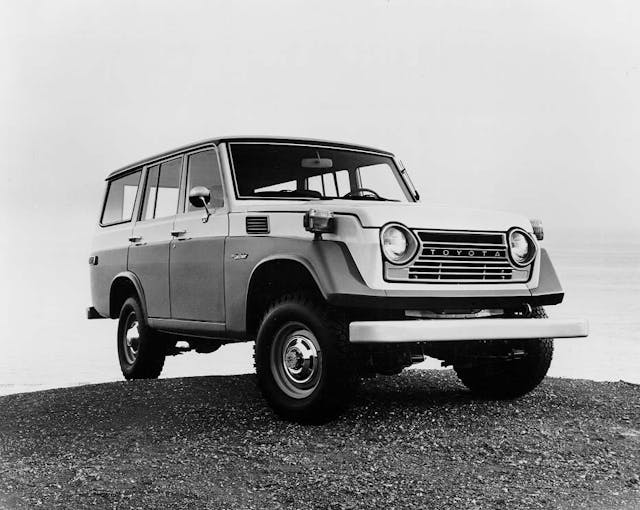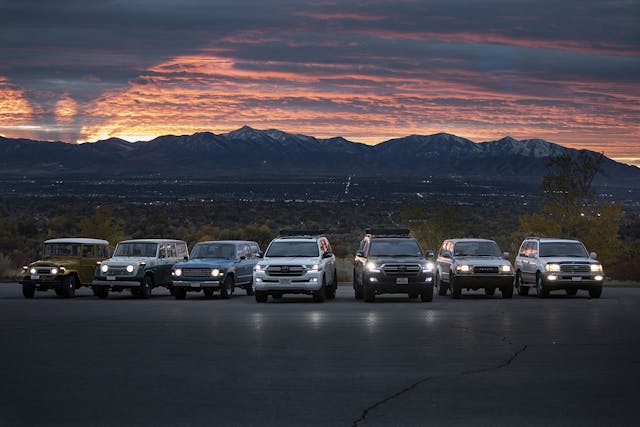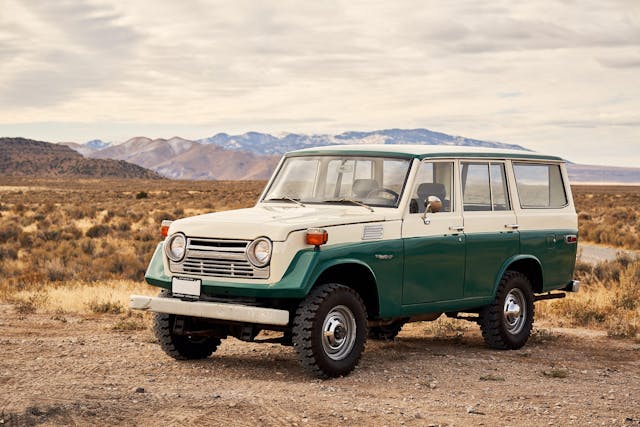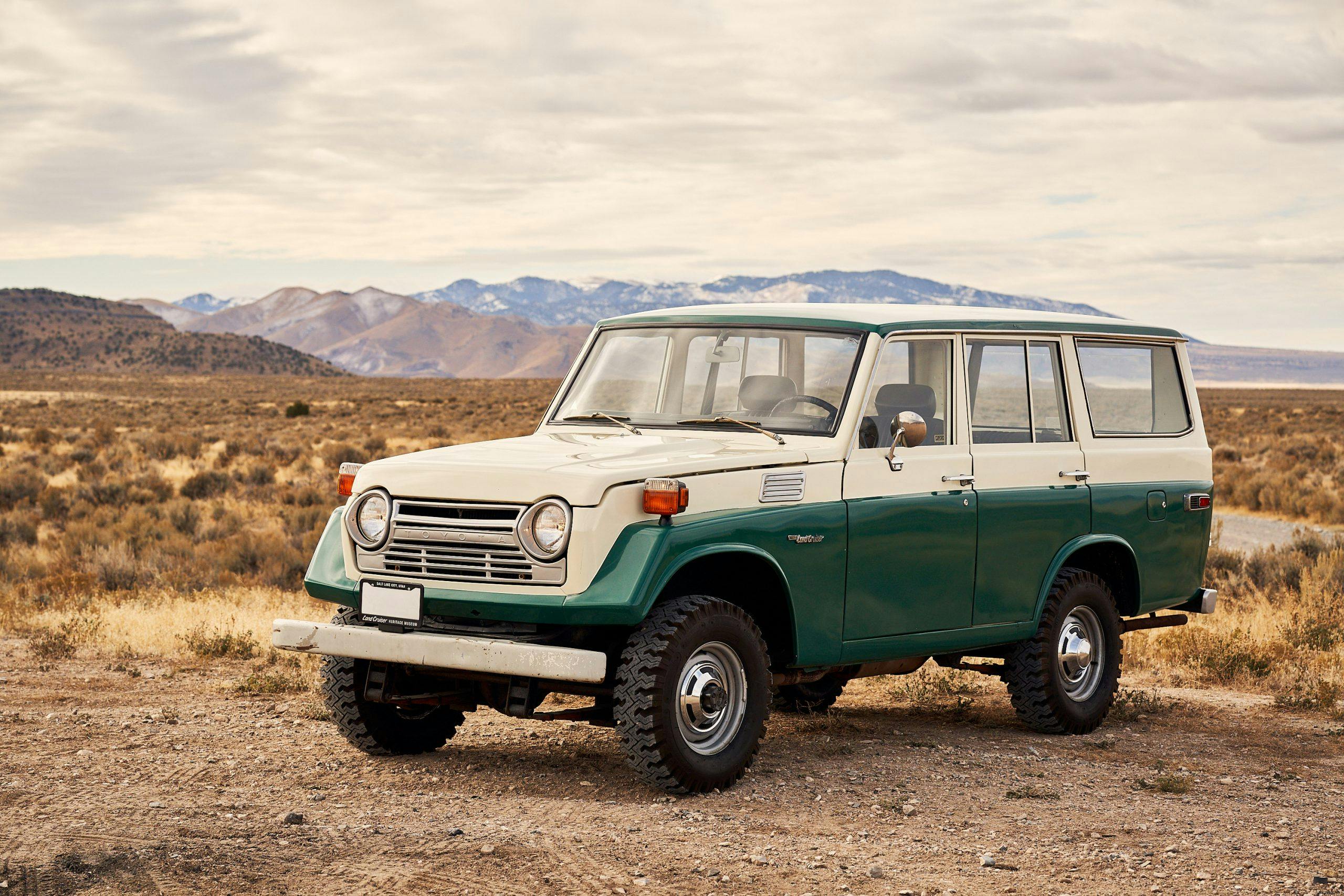Media | Articles
Your handy 1967–80 Toyota FJ55 buyer’s guide
This guide to all things FJ55 originally ran on our site in July of 2021. We’re re-sharing it in 2023 to celebrate the return of the Land Cruiser to U.S. shores after a three-year absence. Enjoy! — Ed.
What makes a Toyota Land Cruiser so appealing? For some, it’s the original Jeep-like vehicle with roots back to 1951. For others, it’s the ability to go just about anywhere with room for the whole family. But unlike today’s luxury-laden Land Cruisers, the FJ55 sports a durable and minimalist demeanor worthy of the original, with a purpose-built body that easily accepts multiple passengers and all of their overlanding necessities to boot. So let’s see how the FJ55’s station-wagon body style grew the audience of Toyota’s Land Cruiser franchise, establishing its desirability and collectability.
1967–74
Introduced in August 1967, the FJ55 replaced the limited-production FJ45LV four-door wagon. While the FJ45LV was a derivation of the FJ40 two-door off roader, the FJ55 was Toyota’s first Land Cruiser model designed from the start to be a wagon. While designated as a van in Japan (hence the “V”), the FJ55 was marketed in the U.S.A. as an alternative to four-door station wagons and the three-door Chevrolet Suburban or the Kaiser/Jeep Wagoneer. To that point, the FJ55 had a large cargo area that also utilized a fold-down rear seat. The bottom-hinged tailgate sported a power-operated window that activated either via a switch on the dashboard or with the key. The tailgate’s motorized window was a rare luxury in an otherwise utilitarian vehicle.

The FJ55’s purpose-built body had a narrow “face” separated from the fenders, with headlamps inset in the grille opening. The two-tone paint job enhanced the front end’s resemblance to a pig’s snout, which created the model a new nickname, the “Iron Pig.” While it may not be the most flattering moniker, the Iron Pig has become a term of endearment. Cosmetic changes to the Iron Pig were extremely minimal, like a modest change to the side marker lights in 1972 that resulted in the addition of a passive cabin ventilation hose.
The FJ55 was close to the Land Cruiser FJ40 under the skin, using the 3.9-liter, overhead-valve Toyota “F” inline-six making 125 horsepower. Some reports suggest this was boosted to 130 horsepower in 1969. The only transmission available was a three-speed manual with a non-synchronized first gear, a two-speed transfer case and part-time four-wheel drive.
1975–80
With ever-tightening emissions regulations in mind, Toyota made the transition to the 2F engine for all FJ55s. This new motor, at 4.2 liters, was larger than its predecessor, had more power (135 hp), and came with a four-speed manual transmission for better performance. The new motor was easy to spot, thanks to a unique hood design with a center-domed hood rising behind that classic Iron Pig front fascia. This hood’s underside also reportedly provided clearance for the revised induction system. A less significant change for 1975 was the transition to a new front turn-signal assembly with both an amber and a clear lens.

Since running changes were modest on such a no-nonsense machine, the next items of note are the revised rear lamp assemblies introduced in 1978. These new lights gave the FJ55 a new look; they were mounted lower on the body and included integral amber turn signals, reverse lights, and red reflectors. Production ended in July of 1980 and the Land Cruiser name was attached to the new FJ60 platform. Running changes were not uncommon in the 13 years of FJ55 production, but mechanical ones tended to run in step with its sistership, the FJ40.
Before you buy
Because FJ55s are durable and share mechanical bits with other Land Cruisers, the three biggest issues you must consider are rust, rust, and more rust. If you aren’t comfortable assessing tin-worm damage, pay for a pre-purchase inspection that examines the entire body and frame with the proverbial fine-tooth comb. The key areas to examine are the roof (especially near the drip rails) and down near the cowl and fenders. Rust is also likely inside the doors, rocker panels, and wheel arches. Chassis rust is just as concerning, so examine the frame rails, body mounts, and anywhere mud can collect and store moisture.
Replacement panels generally do not exist, so if the FJ55 before you needs metalwork, the replacements must likely be fabricated. This is a good time to inspect the quality of rust repair in the past, as not everyone performs rust repair to the same standard. If the example doesn’t pass muster, either lower your offer or walk away from the FJ55 entirely.

Trim is also hard to find. The same goes for weatherstripping, so finding an FJ55 in the best condition for your price range is paramount. The interiors are simple but also a bit fragile, as vinyl seats are likely to be ripped (or already replaced with aftermarket covers). Dash tops and the original rubber floor mats quickly become brittle and crack. While reupholstery is a worthy and valuable option for deteriorated interior parts, an original interior with no rips or cracks will make an FJ55 more desirable.
Interior upgrades may or may not suit your tastes, but switching to disc brakes is generally encouraged, and the upgraded components are easy to source. Still, the stock drum brakes are adequately sized for the FJ55’s modest footprint, so don’t feel the need to upgrade if the original units are in good working order and if the powertrain remains factory-spec. Speaking of, the Toyota F and 2F engines are generally durable, provided they have received basic maintenance and periodic valve adjustments. If something goes wrong under hood, it will be easy and cheap to fix. Well, at least relative to the cost associated with rust repair.
Valuation
While FJ55s don’t draw the same following as the FJ40s, and they aren’t as usable or comfortable as the later Land Cruisers, their rarity and overall appeal have cemented their status in the classic-truck market. Prices have been consistently trending up in the last several years: Since 2020, the median quote value has increased by 65.8 percent. Despite that large percentage gain, values remain reasonable: The median quoted value—measured across all conditions of FJ55—is $34,500. You’ll pay more for a nicer example: A truck in #2, or Excellent condition—you’d have to look very closely to find flaws—carries a median value of $46,300. Most real-world examples aren’t that nice, of course: The median value of all the FJ55s we insure is $24,500, or nearly half that #2 median value. The Hagerty Valuation team has significant insight into FJ55 transaction prices, but please check here for the latest values.

Not only are FJ55s on the uptick, but they are also particularly popular with Gen Xers and younger generations. The former set, which represents 31.44 percent of the market, accounts for 58.5 percent of FJ55s quotes. To be fair, Gen Xers disproportionately like trucks, but millennials and Gen Z are right behind them when it comes to the FJ55, with 33 percent of quotes (for context, these two generations together make up 30.82 percent of the market). Boomers are relatively less interested: Though they comprise 33.46 percent of the market, they represent 24.3 percent of FJ55 quotes. Pre-boomers bring up the rear, with 5.4 percent.
The FJ55 Land Cruiser isn’t for everyone, but the Iron Pig is Toyota’s first dedicated Land Cruiser wagon. It’s a legitimate SUV that’s immensely fun to drive. Prices are likely to continue to rise, so buying an FJ55 sooner rather than later, in the best condition you can find for your budget, is a safe bet for any Toyota devotee—or any vintage-SUV enthusiast.
***
Marketplace
Buy and sell classics with confidence
Check out the Hagerty Media homepage so you don’t miss a single story, or better yet, bookmark it. To get our best stories delivered right to your inbox, subscribe to our newsletters.















All I know is that I regret ever selling my fj55. Gave me the best memories of my life.